St Agnes, Cornwall
St Agnes (Cornish: Breanek)[1] is a civil parish and a large village on the north coast of Cornwall, England, UK. The village is about five miles (8 km) north of Redruth and ten miles (16 km) southwest of Newquay.[2] An electoral ward exists stretching as far south as Blackwater. The population at the 2011 census was 7,565.[3]
St Agnes
| |
|---|---|
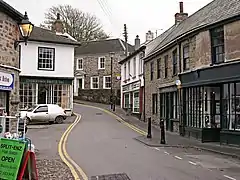 Churchtown, St Agnes | |
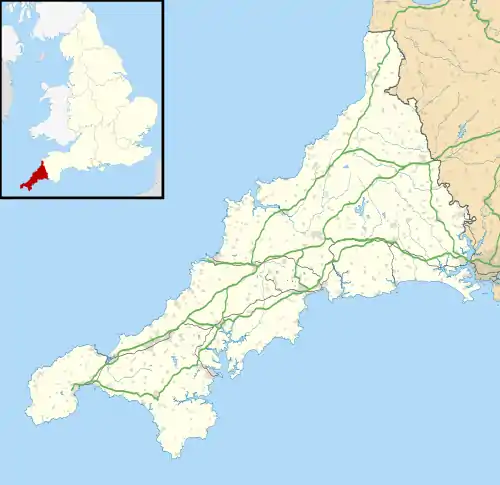 St Agnes Location within Cornwall | |
| Population | 7,565 Parish 7565 including Cross Coombe and Manor Parsley , Village 2230 |
| OS grid reference | SW713507 |
| Unitary authority | |
| Shire county | |
| Ceremonial county | |
| Region | |
| Country | England |
| Sovereign state | United Kingdom |
| Post town | St. Agnes |
| Postcode district | TR5 |
| Dialling code | 01872 55 |
| Police | Devon and Cornwall |
| Fire | Cornwall |
| Ambulance | South Western |
| UK Parliament | |
The village of St Agnes, a popular coastal tourist spot, lies on a main road between Redruth and Perranporth. It was a prehistoric and modern centre for mining of copper, tin and arsenic until the 1920s. Local industry has also included farming and fishing, and more recently tourism.
The St Agnes district has a heritage of industrial archaeology and much of the landscape is of considerable geological interest. There are also stone-age remains in the parish. The manor of Tywarnhaile was one of the 17 Antiqua maneria of the Duchy of Cornwall.
Geography
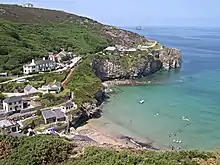

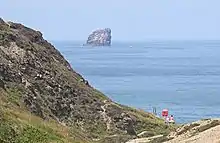
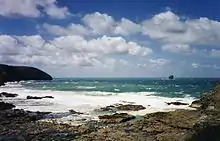
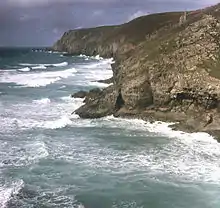
St Agnes, on Cornwall's north coast along the Atlantic Ocean, is in the Pydar hundred and rural deanery.[2][4] St Agnes is situated along the St Agnes Heritage Coast.[5] The St Agnes Heritage Coast has been a nationally designated protected area since 1986. The marine site protects 40 species of mammals and amphibians.[6][7] Interesting features along the coast include Trevaunance Cove, Trevellas Porth, Crams, Chapel Porth, Hanover Cove, and Porthtowan. Some of these have beaches, and there are also two beaches at Perranporth.[8]
The 627-hectare (1,550-acre) Godrevy Head to St Agnes site,[9] is situated along the north Cornwall coast of the Celtic Sea in the Atlantic Ocean. It starts at Godrevy Head (with the Godrevy Towans) in the west and continues for 20 kilometres (12 mi) to the north east, through Portreath, Porthtowan and ends just past St Agnes Head, north of the village of St Agnes.[10][11]
St Agnes Beacon overlooks the Atlantic Ocean and is considered "the most prominent feature" of the Heritage coastline, with coastal and inland views that may be enjoyed during hillside walks. The National Trust landmark's name comes from the Cornish name "Bryanick".[5][12] "Beacon" is a word of Anglo-Saxon origin referring to the use of a hill summit for a warning signal fire.[13] During the Napoleonic Wars a guard was stationed on the hill to look out for French ships and light a warning fire on seeing any.[14]
St Agnes Beacon and the surrounding cliff tops are one of the last remnants of a huge tract of heathland which once spread across Cornwall. This rare and important habitat is internationally recognised for its wealth of wildlife and from late summer onwards comes alive with colour, forming a brilliant yellow and purple patchwork of gorse and heather.
— National Trust[15]
Geology
To the northwest foot of the St Agnes Beacon is Cameron Quarry and St Agnes Beacon Pits, Sites of Special Scientific Interest noted for their geological interest.[16][17] Trevaunance Cove is also a Site of Special Scientific Interest and a Geological Conservation Review site of national importance for ″... the two principal ore-bearing mineral veins associated with the Hercynian St. Agnes-Cligga granite″.[18]
Toponymy
The original name of St Agnes was "Bryanick", a Cornish name which may mean pointed hill (i.e. St Agnes Beacon).[5] Craig Weatherhill suggests it was a compound of brea (hill) and Anek (Agnes) and gives the first recorded form as "Breanek" (1420–99).[19]
Neither Bryanick nor St Agnes, though, were established at the time of the Domesday Survey, 1086; the area was included in Perran Sand (Perranzabuloe). The St Agnes Chapel was named after the Roman martyr Saint Agnes who refused to marry a son of Sempronius, a governor of Rome and member of the Sempronia family. She was killed in 304 AD.[20]
According to Arthur G. Langdon, writing in the 1890s, the inhabitants of St Agnes pronounced its name as if it were "St Anne's" to distinguish it from St Agnes in the Isles of Scilly.[21]
History and antiquities
Antiquities
There are a number of ancient archaeological sites in the St Agnes parish.[22] The earliest found to date are mesolithic fragments which are dated from 10,000 to 4,000 BC. They were found near New Downs and West Polberro.[23]
During the Bronze Age barrows were created in many places in the area,[24][nb 1] which was probably because its rich supply of bronze-making raw materials: copper and tin.[32] During the Iron Age there were more forts and evidence of mining.[33][34][nb 2] A noteworthy Iron Age site is the Caer Dane hillfort, 2.2 mi southeast of Perranporth. It had three concentric defensive walls surrounding the inner, topmost ring.[38] St Piran's enclosed round was 660 feet (200 m) wide and may have been a "playing place" (performance area). During the Middle Ages it was converted to a "Plain-an-gwarry (theatre)". It is still used sometimes as a theatre.[39][40][nb 3]
There are other prehistoric geographic features, but the specific age or time period is unclear.[nb 4] The Bolster Bank, or Bolster & Chapel Bulwark, at Porth, is an univallate earthen boundary about 3.3 kilometres (2.1 mi) long. It was likely used for defensive purposes, protecting the heath and valuable tin resources. Located on the "land side" of St Agnes Beacon, evidence of the bulwark can be seen sporadically from Bolster Farm to Goonvrea Farm, down to Wheal Freedom and then to Chapel Coombes. Although much of the boundary has been levelled, it is presently at its highest by Bolster Farm and Goonvrea where it is about 3.3 metres (11 ft) high. It could have been constructed as early as the Iron Age or some time in the Dark Ages.[51]
Some Iron Age buildings and features were used during the Roman period from 43 to 410 AD.[nb 5]
Middle Ages
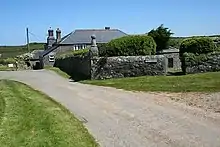
The first chapel or church in St Agnes was believed to have been built as an early Celtic church sometime between 410 and 1066 AD; At that time it also had an enclosure. The Church of St Agnes was built on the same location around 1482.[55][56] A medieval chapel with an enclosure stood at Chapel Porth, about 570 metres north west of Wheal Freedom. There was a holy well and a post-medieval (1540 to 1901) storehouse or shelter on the site. The chapel was destroyed in 1780, and the holy well remained until 1820. There still remains some ruins of the medieval enclosure and the small building.[57]
During the Middle Ages there was tin working at a St Agnes Head tin works site with an extractive pit for openworks and lode back workings.[58] There are also ancient signs of tin works at Wheal Coates, near the Chapel Porth area cliffs. The site includes an adit, which is a tunnel or access to the mine; dam; dressing floor where the ore was processed for smelting; and an open cut where excavation occurred in a ravine on the surface. There were also prospecting pits to locate ore below the surface and a wheel pit for a water wheel. A bothy provided lodging for the miners.[59][60] [nb 6]
A manor was built in St Agnes during the Middle Ages. Between 1700 and 1800 a house was built on the site of the previous manor. It is now a convalescent home.[63][64] A Trevellas country house was built during this period. Sometime between 1540 and 1901 a new house was erected where the country house once stood.[65]
16th and 17th century
A chapel created between 1540 and the 1800s was located just north of Mawla. In its latter years the building was a shed for cows. By 1847 it was in ruins. The St John the Baptist church in Mount Hawke received the font from this church, although its original "Medieval" carvings were lost when the font was resculpted.[66][67]
It was during this period that the Gill family were first recorded to be living in the area. The Gill family have traced their origins to St Agnes from as early as 1565, where it is believed that they were one of the more influential yeoman families.
The area saw an emergence of a variety of industries, such as public houses. The Miners Arms Public House was constructed in Mithian in the 17th century. It saw additions and renovations in the following two centuries. The building exterior is made of granite, killas rubble, brick and elvan. It is roofed in Delabole slate.[68] Trevaunance Cove had a post medieval lime kiln that operated sometime between 1540 and 1901.[69]
18th and 19th century
Medieval mining locations began to take on modern methods of mining in the 19th century, like that at Wheal Coates.[59] Wheal Lushington is thought to have been the biggest tin mining operation in the area. Operational by 1808, smelting was also performed at Wheal Lushington.[70] Modern mining practices were employed at Blue Hills Mine about 1810 and until 1897. There had been prior mining activities in that area before 1780.[71] A number of copper, tin and arsenic mines operated during the 18th, 19th and some into the 20th century.[72]
Allen's Corn Mill operated at Porthtowan between 1752 and 1816.[73]
20th century
From 1903 until 1963 a railway station on the Perranporth line operated in St Agnes. After the railway station closed, the dismantled railway was used for the mining industry.[74]
Between 1939 and 1940, Cameron Camp, also known as the 10th Light Anti-Aircraft Practice Camp, Royal Artillery, was built on the site of a Napoleonic Wars target. The camp was named after an area landowner and served as an army camp, slit trench and anti-aircraft battery. After the war the camp was used for housing. It was levelled in 1971.[75][nb 7]
Religion

There are churches and chapels in the district for three Christian denominations: Anglican, Methodist and Roman Catholic.[77]
Anglican
- St Agnes Parish Church
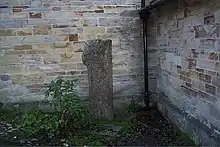
The Church of St Agnes is believed to have been built as a chapel of ease about 1482, on the foundation of what is possibly an ancient Celtic church (410 to 1066 AD). The records of the Diocese of Exeter refer to a chapel of St Agnes in the parish of Perranzabuloe in 1374.[78] In medieval and early modern times St Agnes was part of the parish of Perranzabuloe. In 1846 it was made into a parish church and two years later the building itself, exclusive of the spire and tower, was restored by Piers St Aubyn. In 1905 the spire was rebuilt. It is a Grade II listed building.[55][79]
On the southwest side of the church by the churchyard gate is a granite wayside cross from the Middle Ages. The stone is the remains of a lych stone used for holding coffins.[80] Arthur G. Langdon notes that John Thomas Blight recorded its former use as a lych stone. The head of the stone is incomplete; both part of one side of the head and the uppermost part of the head have been cut off.[21]
- Mount Hawke Parish Church
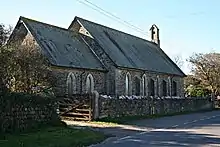
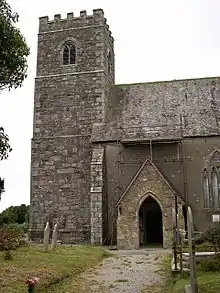
In 1846 the Mount Hawke chapel-of-ease, dedicated to St John the Baptist, was formed from church members who had been meeting in a small building in the village; it became the parish church of the new ecclesiastical parish of Mount Hawke in 1847. The Bishop of Exeter consecrated the stone Perpendicular style building on 5 August 1878.[81]
- Mithian Parish Church
Another Anglican chapel-of-ease was St Peter's Church in Mithian. The Decorated style church was built between Mithian and Blackwater at Chiverton Cross in 1847 and dedicated to St Peter. There had been two or more chapels in Mithian prior to this church. One was at Mawla (subsequently used to shelter cows). The Mithian church closed in 2008.[82]
Methodist
There are several Methodist churches in St Agnes: the former Wesleyan Methodist church, the former United Methodist chapel and a former Primitive Methodist chapel.[77] Mithian previously had a Wesleyan Methodist chapel.[82] Mawla, Mount Hawke, Skinner's Bottom and Porthtowan all also had Wesleyan chapels. Skinner's Bottom also had a Primitive Methodist chapel. Wheal Rose had a Bible Christian chapel.[81]
 The Chapel on the Hill, Methodist Church, Porthtowan
The Chapel on the Hill, Methodist Church, Porthtowan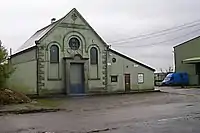 An old Methodist chapel, Wheal Rose
An old Methodist chapel, Wheal Rose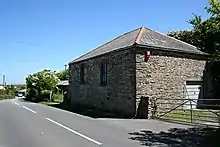 An old Methodist chapel on Trevellas Downs
An old Methodist chapel on Trevellas Downs Our Lady, Star of the Sea
Our Lady, Star of the Sea
Education
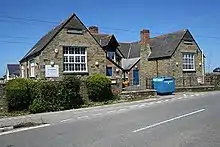
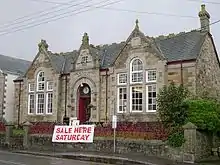
Schools for children ages five to eleven include St Agnes ACE Academy, Mithian Primary School, Blackwater Community Primary School], and Mount Hawke Academy.
Young people from the village and wider parish usually attend secondary and post-16 education at school and colleges in Truro (Richard Lander School, Penair School and Truro and Penwith College), Redruth (Redruth School and Pool Academy) or Camborne (Camborne Science and International Academy and Cornwall College).
Near Blackwater is the Three Bridges Special School for children ages 11 to 19.[84][85]
John Passmore Edwards in 1893 had built and donated the Miners and Mechanics Institute in the village of St Agnes. Individuals could attend lectures or access the library. This one story building was designed by W. J. Willis and its exterior was made of killas and granite. The gabled roof was covered with Delabole slate. Within the building there were two main rooms and other smaller rooms.[86]
Culture
Outdoor activities include beach side walks, swimming, and surfing. The area has a number of paths for coastal walks or cycling. There are also art shows, craft fayres, tea parties and coffee mornings. Music and dancing can be found in the public houses. Annual events are Carnival week, Lifeboat day, Summer plays by the St Agnes Players, Victorian Fair Day and the Bolster the Giant pageant.[87][88]
The Blue Hills area hosts the Motor Cycling Club's Lands End Trial for cars and bikes. The first run being held in 1908.[89] There are several sports clubs including rugby union, football, boxing and netball.[90]
The St Agnes Parish Museum provides information about the history of the St Agnes area. Mining and the coastal history figure prominently, including a 700-pound (320 kg) leatherback turtle.[91]
Economy
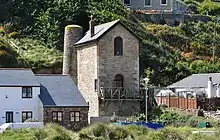
Historically, St Agnes and the surrounding area relied on fishing, farming and mining for copper and tin.[92] There were also iron foundries and an iron works, stamps and crazing mills, a smelter, blowing houses and clay extraction.[93]
By the 1930s mining and related industries had nearly ceased and by the 1950s the area had very little industrial commerce. Instead, the area became a bedroom community for workers in the surrounding towns and cities like Newquay and Truro, a desired retirement community and a favoured holiday spot. The mining history is part of the draw for tourists, like the Blue Hills Tin Streams where tourists can see tin work demonstrations.[94]
St Agnes village is relatively self-sufficient with local shops and business enterprises that support the village itself and the surrounding farming country.[94][95]
Agriculture
Prior to the mid-19th century, the moors and waste land would not support a great agricultural industry. Although after the land was agriculturly improved, there was an increase in the number of farms. In 1878 after the enclosure of heath, cultivation had almost reached the summit of St Agnes Beacon.[96] By the late 19th century it was the "largest single trade in the locality and parish". Maltings, a related industry operated in Peterville in the 19th century.[97]
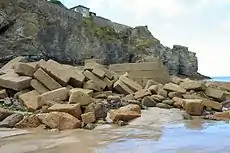
Harbour
Since the 17th century there have been many attempts to create a harbour for St Agnes. Between 1632 and 1709 the Tonkins, lords of the manor of Trevaunance, expended the family legacy as they tried to build a harbour. Three attempts were made, the last of which was assisted by Henry Winstanley, but that harbour was washed away in 1705.[98] The harbour built in 1710 by an unrelated party was levelled in 1730 by the crashing Atlantic Ocean waves. A new harbour constructed in 1798 supported a fishing industry and allowed for the export of copper ore and the import of coal from South Wales for the smelters at the mines. St Agnes remained a busy port until the collapse of the harbour wall in a storm in 1915/16. There are only remains of the old harbour in existence.[99][100][101]
In 1802, a pilchard fishing industry was established from the harbour, reaching its peak in 1829 and 1830 before declining.[99]
Mining
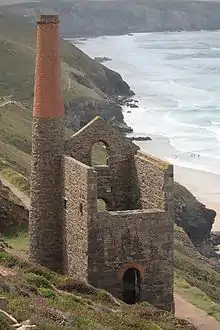
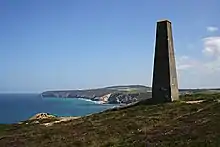
Cornwall, along with its neighbouring county of Devon, was an important source of tin for Europe and the Mediterranean throughout ancient times, but began dominating the market during late Roman times in the 3rd century AD with the exhaustion of many Spanish tin mines.[102] Cornwall maintained its importance as a source of tin throughout medieval times and into the modern period.[103]
At their height about 100 mines employed 1000 miners. Mining came to an end in the 1920s and many of these mines are still on view for tourists.[92] United Hills mine produced 86,500 tons of copper ore, 1826–1906; and Wheal Towan 54,610 tons, 1800-31. Lesser quantities of black tin were produced from these mines: West Wheal Kitty 10,070 tons (1881–1915); Wheal Kitty 9,510 tons (1853–1918); Polberro 4,300 tons (1837–95); Penhalls 3,610 tons (1834–96); and Blue Hills 2,120 tons (1858–97).[104] Much of the Cornwall and West Devon Mining Landscape, a World Heritage Site, is in the parish.[105] Tin production is still worked at the Blue Hills Tin Streams [106][107]
Wheal Coates was the site of medieval mining between 1066 and 1540, and it was a modern mining producer from 1802 and into the 20th century.[59] The visible remains of Wheal Coates are the engine houses built in the 1870s to crush ore, run a Calciner, or pump water. The sites, owned by the National Trust, include the Whim Engine House, Towanroath Pumping Engine House and the Calciner. Before that the Jericho valley, where Blue Hills Tin Streams operated, had supported mining operations for centuries.[108] At Chapel Coombe a set of old Cornish stamps has been re-erected by the Trevithick Society.[109] Stippy Stappy is a row of 18th century cottages on a very steep incline.[110]
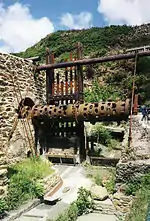 St Agnes: Blue Hills Tin Streams. Water-powered Cornish Stamps used for dressing tin.
St Agnes: Blue Hills Tin Streams. Water-powered Cornish Stamps used for dressing tin.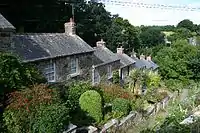 Stippy Stappy miners' cottages
Stippy Stappy miners' cottages
Tourism
St Agnes is a popular tourist destination. The coastal area is maintained by the National Trust and is designated part of the Cornwall Area of Outstanding Natural Beauty (AONB).[111] Beaches in the St Agnes Parish include Trevaunance Cove, near the village of St Agnes. It is a small sandy beach with lifeguards and adequate parking. Porthtowan village also has a sandy beach. Trevellas Porth is popular with divers and fishermen, but because it is quite rocky it is not recommended for swimming. Chapel Porth is another area beach.[112]
Demographics
The population of the St Agnes Parish is made up of the people in two St Agnes groupings, Blackwater, Mount Hawke, Porthtowan and Wheal Rose. In 2010, the population was 1,440 in St Agnes Central and 2,480 in St Agnes Fringe, Mithian and Trevellas for a total of 3,920 people.[113][114] In Blackwater and Mount Hawke there were 2,130 people[115] and in Porthtowan and Wheal Rose there were an additional 1,580 people.[116] The total of the numbers from the Neighbourhood profiles is 7,630.
| Description | St Agnes Central | St Agnes Fringe, Mithian and Trevellas | Blackwater and Mount Hawke | Porthtowan and Wheal Rose | Total | Percentage of Total Working Aged |
|---|---|---|---|---|---|---|
| Working aged | ||||||
| Not claiming benefits | ||||||
| Out of work benefits | ||||||
| Other benefits, includes carers, disabled, bereaved and unknown | ||||||
The statistics above were compiled from individual municipality information. The following is an aggregate statistic of the Community Network Area that St Agnes shares with Perranporth for managing local governmental activities with Cornwall Council:
| Community Network Area | Age 0-15 | Working age | Age 65+ | All Ages |
|---|---|---|---|---|
| St Agnes and Perranporth | 2,700 | 10,600 | 4,100 | 17,400 |
This represents a 6% growth since 2001. With a total network area of 12,453 hectares, the population density is 1.40 acres/person.[118]
Government and politics
The St Agnes Parish wards include Blackwater, Mithian, Mount Hawke, St Agnes, and Porthtowan.[119][120] Council members make decisions on parish business through the Environment, Planning, Property & Devolved Services, and Human Resources committees and via Full Council meetings in accordance with established policies and procedures.[121][122] Parish Council staff run the Parish Council on behalf of Councillors and the community. [123]
Since 1 July 1837 St Agnes has been continuously registered in the Truro Registration district.[124] In 1974, local districts were created to manage local government as the result of the Local Government Act 1972.[125] Under The District of Carrick (Electoral Changes) Order 2002, Carrick District, which had managed the parish of St Agnes and other wards, would be dissolved and St Agnes would manage its own local government with three parish councillors.[126][127] Since June 2009 it has been part of the St. Agnes and Perranporth Community Network of the Cornwall Council.[128]
Transport
There is bus service within Cornwall by a number of operators. The major operator in the Cornwall area is First Kernow.[129][130] Service runs through the village of St Agnes and other towns.[131][132] Rail service is offered out of Newquay railway station, Redruth railway station, Truro railway station and other western Cornwall municipalities, which is connected with bus service through the Ride Cornwall and Plusbus programs.[133]
Ferry service is available to the Isles of Scilly from Penzance; Padstow to Rock; and other locations.[134] Air travel is available through Newquay Cornwall Airport.[135]
Notable people
- John Passmore Edwards, philanthropist
- John Opie, notable painter, born at Trevellas
- Thomas Tonkin (1678–1742), Cornish landowner and historian.
- George Smiley fictional intelligence officer
- Louise Cooper, writer
See also
Notes
- Near Carn Gowla is a Bronze Age (2600 to 700 BC) clearance cairn field, which seems to indicate a particular plan, such as the clearance of a field for agriculture.[25][26][27] The Trevellas Barrow site lies at the end of one of the Trevellas Airfield runways. Excavated in 1940 by Charles Kenneth Croft Andrew, the site is believed to be a tumulus or burial site that had a bucket urn and pottery sherds. It was defined as an "intact ritual deposit", probably from about 2000 BC. There are no sign of its former shape.[28] A larger barrow site east of St Agnes village shows evidence of cremation and up to eight barrows.[29] St Agnes Beacon is the site of several barrows or cairns from this age. It was later a beacon point sometime between 1580 and 1732 and a prospect tower between 1767 and 1799.[30] There were other Bronze Age barrows in the area.[31]
- On St Agnes Beacon is the site of an Iron Age hillfort and oval enclosure. The enclosure follows the northern edge of the hill for 180 metres (590 ft).[33] Just south of Mount Hawke was an Iron Age round and 60 by 70 metres (200 by 230 ft) enclosure. There may have also have been mining or quarry activity on this site during the Middle Ages.[34] Northwest of Wheal Rose was an Iron Age building, a terraced field system, and an excavation pit.[35][36] On the coast, west of St Agnes Beacon, is a piece of land called Tubby's Head. It was an Iron Age (800 BC to 43 AD) promontory fort or quay about 20 by 2.3 metres (65.6 by 7.5 ft). A causeway entrance exists to the north side of the site.[37]
- Bronze Age and Iron Age material goods that have been excavated include arrowheads, axes, stone tools and vessels, and spindle whorls.[41]
- Caer Kief, for instance, is a prehistoric earthwork or hillfort defined as a "round", which means a small Iron Age settlement, but its dates of construction and habitation are unclear. Located south of Carnkief and west of Wheal Frances, it is a subsquare camp measuring 120 by 125 metres (394 by 410 ft). Located on the crest of a ridge, it is encircled by a stone rampart, bank and ditch; the east-west bank was 380 metres (1,250 ft) long.[42][43] There is also the prehistoric Four Burrows.[8] South of Mount Hawke was a late prehistoric settlement of unenclosed huts.[44][45] Nearby, close to the houses at Menagissey, are two late prehistoric or Roman rounds with a circular enclosure. They are "the most westerly of a series of apparently associated earthworks seen by (Charles) Thomas which ran between Menagissey and Coosewartha."[46][47] Other rounds and field systems are found in the area.[48][49][50]
- Northwest of Wheal Rose and west of Skinners Bottom was building, a terraced field system, and an excavation pit.[35] South of Mount Hawke, near the houses at Menagissey, are rounds with a circular enclosure built during the late prehistoric period that continued to be used through this period.[46] Also in the area were other rounds and field systems used in a previous and Roman period.[34][48][49][50] Closer to the coast, just southwest of Towan Cross, was a set of rounds and circular enclosures built during the late prehistoric period that have evidence of use during the Roman occupation.[52][53] Roman Coins through the 4th century AD were found in the St Agnes Parish area.[54]
- A medieval rabbit farm was found on St Agnes Head; It was identified by the presence of pillow mounds.[61][62]
- Cameron Camp was built upon a Napoleonic Wars target, which was built in 1799 and operated through 1815. The target was raised when Cameron Camp was built for World War II.[75][76]
References
- Place-names in the Standard Written Form (SWF) : List of place-names agreed by the MAGA Signage Panel Archived 15 May 2013 at the Wayback Machine. Cornish Language Partnership.
- Ordnance Survey: Landranger map sheet 203 Land's End. ISBN 978-0-319-23148-7. and Ordnance Survey: Landranger map sheet 200 Newquay & Bodmin. ISBN 978-0-319-22938-5.
- "Ward population 2011". Retrieved 12 February 2015.
- St Agnes. Vision of Britain. Retrieved 19 September 2012.
- St Agnes Heritage Coast. British Express. Retrieved 18 September 2012.
- St Agnes Heritage Coast. Protected Planet. Retrieved 18 September 2012.
- Species Protected Planet: St Agnes Heritage Coast. Retrieved 18 September 2012.
- St Agnes Cornwall. Explore Britain. Retrieved 19 September 2012.
- "Godrevy Head to St Agnes" (PDF). Natural England. 1989. Retrieved 6 December 2011.
- "Godrevy Head to St Agnes map". Natural England. Archived from the original on 13 October 2012. Retrieved 6 December 2011.
- Ordnance Survey: Landranger map sheet 203 Land's End ISBN 978-0-319-23148-7
- St Agnes Beacon. St Agnes Chamber of Commerce. Retrieved 18 September 2012.
- Macdonald, A. M., ed. (1972) Chambers Twentieth Century Dictionary. Edinburgh: Chambers; p. 111.
- Mee, Arthur (1937) Cornwall. (The King's England.) London: Hodder & Stoughton; p. 195
- St Agnes and Chapel Porth. National Trust. Retrieved 18 September 2012.
- "Cameron Quarry" (PDF). Natural England. 1996. Retrieved 26 October 2011.
- "St Agnes Beacon Pits" (PDF). Natural England. 1986. Retrieved 26 October 2011.
- "Trevaunance Cove" (PDF). Natural England. 1993. Retrieved 1 November 2011.
- Weatherhill, Craig. (2009) A Concise Dictionary of Cornish Place-names, Westport, Co. Mayo: Evertype; p. 62
- Samuel Drew. The History of Cornwall: From the Earliest Records and Traditions, to the Present Time. W. Penaluna; 1824 [cited 21 September 2012]. pp. 16-17.
- Langdon, Arthur G. (1896) Old Cornish Crosses. Truro: Joseph Pollard, p. 77
- Search on: St Agnes Cornwall. English Heritage National Monuments. Retrieved 21 September 2012.
- Monument No. 428381 - New Downs / West Polberro Monolith., Monument No. 428381 - New Downs / West Polberro Monolith - map. and Monument No. 428408 - New Downs / West Polberro Monolith. English Heritage National Monuments. Retrieved 21 September 2012.
- Search on: St Agnes Cornwall Barrow. English Heritage National Monuments. Retrieved 21 September 2012.
- Monument No. 1151996. English Heritage National Monuments. Retrieved 19 September 2012.
- Clearance Cairn. English Heritage National Monuments. Retrieved 19 September 2012.
- Map of Monument No. 1151996. Retrieved 19 September 2012.
- Trevellas Barrow. English Heritage National Monuments. Retrieved 20 September 2012.
- Monument No. 428346 - St Agnes Barrow. English Heritage National Monuments. Retrieved 20 September 2012.
- Monument No. 428343 - St Agnes Beacon Barrow, Beacon, and Tower. English Heritage National Monuments. Retrieved 20 September 2012.
- Middle Barrow., Monument No. 427903 - Goonown Barrow., Mingoose Barrow., Monument No. 427915 - Mount Hawke Area Barrow., Monument No. 427924 - Skinners Bottom Area Barrow., Monument No. 427912 - Two Burrows Farm Area Barrow., and Monument No. 427942 - Mount Hawke and Two Burrows Farm Area Barrow. English Heritage National Monuments. Retrieved 20 September 2012.
- History of St Agnes. Archived 27 September 2013 at the Wayback Machine Cornwall Tourism Magazine. Retrieved 21 September 2012.
- Monument No. 428361 - Agnes Beacon Iron Age Hillfort. English Heritage National Monuments. Retrieved 21 September 2012.
- Monument No. 427939 - Mount Hawke Area Iron Age round and enclosure. English Heritage National Monuments. Retrieved 21 September 2012.
- Monument No. 1137598 - Wheal Rose Area Iron Age building and terraced field. English Heritage National Monuments. Retrieved 21 September 2012.
- Monument No. 1137598 - Wheal Rose Area Iron Age building and terraced field - map. English Heritage National Monuments. Retrieved 21 September 2012.
- Monument 426274 - Promontory fort or landing point. English Heritage National Monuments. Retrieved 19 September 2012.
- Caer Dane. English Heritage National Monuments. Retrieved 19 September 2012.
- St Piran's Round. English Heritage National Monuments. Retrieved 19 September 2012.
- St Piran's Round - map. English Heritage National Monuments. Retrieved 19 September 2012.
- "Advanced Search on: St Agnes Cornwall FINDSPOT (monument type). English Heritage National Monuments. Retrieved 21 September 2012.
- Caer Kief. English Heritage National Monuments. Retrieved 19 September 2012.
- Caer Kief - Old map English Heritage National Monuments. Retrieved 19 September 2012.
- Monument No. 427930 - Mount Hawke Area Unenclosed Hut Settlement English Heritage National Monuments. Retrieved 21 September 2012.
- Monument No. 427930 - Mount Hawke Area Unenclosed Hut Settlement - map English Heritage National Monuments. Retrieved 21 September 2012.
- Monument No. 4427933 - Mount Hawke Area Late Prehistoric or Roman Rounds English Heritage National Monuments. Retrieved 21 September 2012.
- Monument No. 4427933 - Mount Hawke Area Late Prehistoric or Roman Rounds - map English Heritage National Monuments. Retrieved 21 September 2012.
- Monument No. 427936 - Mount Hawke Area Late Prehistoric or Roman (43-410 AD) Rounds English Heritage National Monuments. Retrieved 21 September 2012.
- Monument No. 427948 - Coosewartha Area Late Prehistoric or Roman (43-410 AD) Rounds English Heritage National Monuments. Retrieved 21 September 2012.
- Monument No. 427949 - Coosewartha Area Late Prehistoric or Roman (43-410 AD) Field Systems English Heritage National Monuments. Retrieved 21 September 2012.
- Bolster Bank. English Heritage National Monuments. Retrieved 19 September 2012.
- Monument No. 427918 - Towan Cross Area Late Prehistoric or Roman (43-140 AD) Rounds and Circular Enclosures English Heritage National Monuments. Retrieved 21 September 2012.
- Monument No. 427918 - Towan Cross Area Late Prehistoric or Roman (43-140 AD) Rounds and Circular Enclosures - map English Heritage National Monuments. Retrieved 21 September 2012.
- Advanced search on: St Agnes Cornwall Roman period. English Heritage National Monuments. Retrieved 21 September 2012.
- Church of St Agnes. English Heritage National Monuments Record. Retrieved 19 September 2012.
- Monument No. 428376 - Medieval Chapel / Church of St Agnes. English Heritage National Monuments. Retrieved 21 September 2012.
- Monument No. 426049 - Medieval Chapel. English Heritage National Monuments. Retrieved 20 September 2012.
- Monument No. 1152214 - Medieval tin working site. English Heritage National Monuments. Retrieved 20 September 2012.
- Monument No. 426049 - Wheal Coates Mine. English Heritage National Monuments. Retrieved 21 September 2012.
- Adit., Dressing floor., Bothy., Prospecting pit., Open cut., Wheel pit. English Heritage National Monuments. Retrieved 21 September 2012.
- Monument No. 1152135 - Pillow Mounds. English Heritage National Monuments. Retrieved 20 September 2012.
- Pillow Mound. English Heritage National Monuments. Retrieved 20 September 2012.
- Monument No. 428386 - Trevaunance Medieval Manor House. English Heritage National Monuments. Retrieved 21 September 2012.
- Monument No. 428386 - Trevaunance Medieval Manor House - map. English Heritage National Monuments. Retrieved 21 September 2012.
- Trevellas House. English Heritage National Monuments. Retrieved 21 September 2012.
- Monument No. 427954 - Mawla area chapel. English Heritage National Monuments. Retrieved 20 September 2012.
- Monument No. 427954 - Mawla area chapel. English Heritage National Monuments. Retrieved 20 September 2012.
- Miners Arms Public House. English Heritage National Monuments. Retrieved 21 September 2012.
- Monument No. 428402 - Lime Kiln. English Heritage National Monuments. Retrieved 21 September 2012.
- Wheal Lushington. English Heritage National Monuments. Retrieved 21 September 2012.
- Blue Hills Tin Mine. English Heritage National Monuments. Retrieved 19 September 2012.
- Advanced Search on: St Agnes Cornwall Post Medieval Industry (theme). English Heritage National Monuments. Retrieved 21 September 2012.
- Allen's Mill. English Heritage National Monuments. Retrieved 21 September 2012.
- St Agnes Station. English Heritage National Monuments. Retrieved 19 September 2012.
- 10th Light Anti-Aircraft Practice Camp, Royal Artillery. English Heritage National Monuments. Retrieved 21 September 2012.
- Target. English Heritage National Monuments. Retrieved 21 September 2012.
- Church History. St Agnes. GENUKI. Retrieved 22 September 2012.
-
- Oliver, George (1846) Monasticon Dioecesis Exoniensis: being a collection of records and instruments illustrating the ancient conventual, collegiate, and eleemosynary foundations, in the Counties of Cornwall and Devon. Exeter: P. A. Hannaford
- Cornish Church Guide (1925) Truro: Blackford; pp. 53-54.
- Monument No. 428373 / Wayside Cross at the Church of St Agnes. English Heritage National Monuments Record. Retrieved 19 September 2012.
- Church History. Archived 21 August 2012 at the Wayback Machine Mount Hawke. GENUKI. Retrieved 23 September 2012. Also see:Mount Hawke Parish Church Archived 10 February 2012 at the Wayback Machine.
- Church History. Mithian. GENUKI. Retrieved 23 September 2012. Also see:Mithian Parish Church.
- Pevsner, N. (1970) Cornwall; 2nd ed. Penguin; p. 155
- Three Bridges School. All The Schools. Retrieved 23 September 2012.
- Three Bridges School. Department for Education. Retrieved 23 September 2012.
- Miners and Mechanics Institute. Miners and Mechanics Institute - map. English Heritage National Monuments. Retrieved 19 September 2012.
- Activities. St Agnes Chamber of Commerce. Retrieved 21 September 2012.
- Events. St Agnes Chamber of Commerce. Retrieved 21 September 2012.
- Landsend. The Motorcycling Club. Retrieved 22 September 2012.
- Sports Clubs. St Agnes Sports Club. Retrieved 22 September 2012.
- St Agnes museum homepage. Retrieved 6 December 2010.
- Clegg, David (2005). Cornwall & the Isles of Scilly. Leicester: Matador. p. 87.
- Cornwall Industrial Settlements Initiative - St Agnes Area. Historic Cornwall. p. 10. Retrieved 22 September 2012.
- Cornwall Industrial Settlements Initiative - St Agnes Area. Historic Cornwall. pp. 11. Retrieved 22 September 2012.
- About. St Agnes Chamber of Commerce. Retrieved 6 December 2010.
- "St Agnes". The Cornishman (5). 15 August 1878. p. 5.
- Cornwall Industrial Settlements Initiative - St Agnes Area. Historic Cornwall. pp. 10-11. Retrieved 22 September 2012.
- Mee, Arthur (1937) Cornwall. (The King's England.) London: Hodder & Stoughton; pp. 195-96
- Cornwall Industrial Settlements Initiative St Agnes. Cornwall Historic Environment Service. December 2002. Retrieved 30 April 2010.
- St Agnes - The Harbour. Archived 27 September 2013 at the Wayback Machine Cornwall Tourism Magazine. Retrieved 21 September 2012.
- Clegg, David (2005) Cornwall & the Isles of Scilly. Leicester: Matador; p. 89
- Gerrard, S. (2000), The Early British Tin Industry, Stroud: Tempus Publishing, ISBN 0-7524-1452-6. p. 21.
- Gerrard, S. (2000), The Early British Tin Industry, Stroud: Tempus Publishing, ISBN 0-7524-1452-6
- Barton, D. B. (1965) A Guide to the Mines of West Cornwall; 2nd ed. Truro: D. Bradford Barton; p. 47
- The World Heritage Site Areas. Archived 26 April 2007 at the Wayback Machine Cornwall & Scilly Historic Environment Service, 2006. Retrieved 25 May 2007.
- http://www.bluehillstin.com
- Cornish Mining Development Association (2007) Annual Report for 2006
- Mining in St Agnes. Archived 27 September 2013 at the Wayback Machine Cornwall Tourism Magazine. Retrieved 21 September 2012.
- Todd, A. C. & Laws, Peter (1972) The Industrial Archaeology of Cornwall. Newton Abbot: David & Charles; p. 221
- St Agnes. Pocket Britain. Retrieved 22 September 2012.
- What is an AONB?. Archived 29 August 2013 at the Wayback Machine Cornwall Areas of Outstanding Natural Beauty (AONB). Retrieved 21 September 2012.
- Beaches at St Agnes. Archived 27 September 2013 at the Wayback Machine Cornwall Tourism Magazine. 21 September 2012.
- St Agnes Fringe, Mithian And Trevellas. Neighbourhood profiles map. Cornwall Council. Retrieved 22 September 2012.
- St Agnes Central. Neighbourhood profiles map. Cornwall Council. Retrieved 22 September 2012.
- Blackwater and Mount Hawke. Neighbourhood profiles map. Cornwall Council. Retrieved 22 September 2012.
- Porthtowan and Wheal Rose. Archived 27 October 2011 at the Wayback Machine Neighbourhood profiles map. Cornwall Council. Retrieved 22 September 2012.
- Community Network Area Populations. (Select St Agnes and Perranporth: population profile) Cornwall Council. Retrieved 22 September 2012.
- St Agnes and Perranporth: population profile. Community network profiles. Cornwall Council. p. 1. Retrieved 22 September 2012.
- St Agnes Parish Wards. St Agnes Parish Council. Retrieved 17 April 2020.
- Villages in St Agnes Parish. St Agnes Chamber of Commerce. Retrieved 22 September 2012.
- St Agnes Parih Council committees. St Agnes Parish Council. Retrieved 17 April 2020.
- St Agnes Parish Council policies. St Agnes Parish Council. Retrieved 17 April 2020.
- St Agnes Parish Council staff. St Agnes Parish Council. Retrieved 17 April 2020.
- Civil Registration. GENUKI. Retrieved 21 September 2012.
- New Local Government Areas. United Kingdom Government Legislation. The National Archives. Retrieved 21 September 2012.
- Wards of the District of Carrick. The District of Carrick (Electoral Changes) Order 2002. United Kingdom Government Legislation. The National Archives. Retrieved 21 September 2012.
- Schedule 1 - Names and Areas of Wards and Number of Councillors. The District of Carrick (Electoral Changes) Order 2002. United Kingdom Government Legislation. The National Archives. Retrieved 21 September 2012.
- St. Agnes and Perranporth Community Network. Cornwall Council. Retrieved 21 September 2012.
- Bus Operators. Archived 18 October 2012 at the Wayback Machine Cornwall Public Transport. Retrieved 22 September 2012.
- Bus tickets. Archived 24 June 2012 at the Wayback Machine Cornwall Public Transport. Retrieved 22 September 2012.
- St Agnes Town Plan. Cornwall Public Transport. Retrieved 22 September 2012.
- Bus maps. Archived 26 June 2012 at the Wayback Machine Cornwall Public Transport. Retrieved 22 September 2012.
- West Cornwall Guide. Archived 24 May 2012 at the Wayback Machine Cornwall Public Transport. Retrieved 22 September 2012.
- Ferries. Archived 8 June 2015 at the Wayback Machine Cornwall Public Transport. Retrieved 22 September 2012.
- Main Page / Travel. Newquay Cornwall Airport. Retrieved 22 September 2012.
Further reading
- Foster, R. J. (1964) St Agnes Methodist Church.
External links and references
| Wikimedia Commons has media related to St Agnes, Cornwall. |
